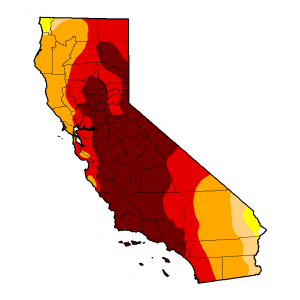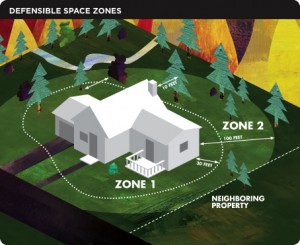California is parched, and bracing for another scary fire year. Once again, much needed rain and snow has eluded the state. The snow pack is a paltry six percent of normal and this January through March was the driest ever in recorded history. The U.S. Drought Monitor has much of the Golden State in extreme or exceptional drought.
In many areas the unprecedented drought has reduced the greenery to dried sticks and CAL FIRE is warning that moisture content in fuels like trees and grasses are at extremely low levels – leaving them tinder dry and susceptible to wildfire.
2015 Exceptional Drought-U.S. Drought Monitor
The National Interagency Fire Center is predicting above normal wildland fire potential for much of California, starting in May and June and continuing through fall.
It is imperative that you take steps NOW to protect your home and property.
That’s why California Casualty has prepared this important fire prevention information, because we have a stake in keeping you, your family and your most important asset as safe as possible.
Home Wildfire Prevention Tips:
- Create a 30-foot defensible space around your home by removing as much flammable material as you can. Replace flammable vegetation with fire resistive plants.*
- Reduce the number of trees in heavily wooded areas by spacing native trees and shrubs at least 10 feet apart. On trees taller than 18 feet, prune lower branches six to ten feet off the ground.
- Remove branches overhanging the roof or coming within 10 feet of the chimney. Clean all dead leaves and needles from the roof, gutters, and yard.
- Install a roof that meets a fire classification of “Class B” or better. Cover the chimney outlet and stovepipe with nonflammable screening no larger than half-inch mesh.
- Install dual- or triple-paned windows, and limit the size and number of windows that face large areas of vegetation.
- Put woodpiles and liquid propane gas tanks at least 30 feet from all structures and clear away flammable vegetation within 10 feet of those woodpiles and propane tanks.
*California Casualty has a free “Reducing Wildfire Risk” pamphlet available here. You can also find additional helpful information linked from our home insurance page.
Help Firefighters Save Your Home!
- Make access easy. Roads need to be wide enough to accommodate fire trucks with room for them to turn around. Driveways and bridges must be strong enough to carry heavy emergency vehicles and equipment. Identify at least two ways to and from your house and make sure they are clearly marked. All access routes should be free of low hanging tree branches and cleared of flammable vegetation at least 10 feet from roads and five feet from driveways.
- Maintain an emergency water supply that meets fire department standards, such as a community water hydrant system, or a cooperative emergency storage tank with neighbors. If your water comes from a well, consider an emergency generator to operate the pump during a power failure. Clearly mark all water sources and create easy access to your closest emergency water source.
If You’re Forced to Evacuate:
- Know the best routes to safe areas and practice them with your family.
- Prepare an evacuation kit ahead of time.
- Know where and how you and your family will reconnect if you become separated.
In case of possible evacuation, your kit should contain the following items:
- Social Security cards
- Driver’s licenses
- Credit cards
- House deed
- Copies of vehicle titles
- Marriage license
- Birth certificates
- Copies of insurance policies
- Home inventory list / photos
- Health insurance cards
- Prescription medications
- Baby food or formula (if you have little ones)
- Important personal computer information downloaded to disk
- Valuable jewelry
- Photographs
- Home videos
- Items with sentimental value, such as wedding dress or baby keepsakes
- One week’s worth of clothing
- Pets with ID tags, carriers, and pet food
FEMA has more information about evacuation kit and plans at https://www.ready.gov/build-a-kit
Insurance Tips if You’re Impacted:
- Residents evacuated from their homes should contact their insurance agents or companies immediately and let them know where they can be reached. As adjusters are allowed into the burned-out areas they will want to go in with their policyholders to assess the damage. Many companies will set up 24-hour emergency hotlines.
- Keep receipts. Out of pocket expenses during a mandatory evacuation are reimbursable under most standard homeowner policies.
- Be prepared to give your agent or insurance representative a description of your damage.
- Take photos of the damaged areas. These will help with your claims process and will assist the adjuster in the investigation.
- Prepare a detailed inventory of all damaged or destroyed personal property. Be sure to make two copies-one for yourself and one for the adjuster. Your list should be as complete as possible, including a description of the items, dates of purchase or approximate age, cost at time of purchase and estimated replacement cost.
- Make whatever temporary repairs you can. Cover broken windows, damaged roofs and walls to prevent further destruction. Save receipts for supplies and materials you purchase. Your company will reimburse you for reasonable expenses in making temporary repairs.
- Secure a detailed estimate for permanent repairs to your home from a reliable contractor and give it to the adjuster. The estimate should contain the proposed repairs, repair costs and replacement prices.
- Serious losses will be given priority. If your home has been destroyed or seriously damaged, your agent will do everything possible to assure that you are given priority.
Don’t forget to make a complete inventory of all the items in your home before disaster strikes – doing so will help if you have to make a claim.
Here’s a List of Fire Prevention Resources:
www.calfire.ca.gov/fire-prevention
https://www.redcross.org/images/MEDIA_CustomProductCatalog/m4340149_Wildfire.pdf
https://www.ready.gov/build-a-kit
https://www.knowyourstuff.org/iii/login.html
A defensible space pamphlet from California Casualty can be found on our resource page, www.calcas.com/resources.
- California Casualty Earns Financial Stability Rating® of A, Exceptional, From Demotech, Inc. - April 28, 2025
- Music & Arts Grant Recipients – 2024 - December 13, 2024
- Understanding Auto and Home Insurance Rate Changes - December 3, 2024


